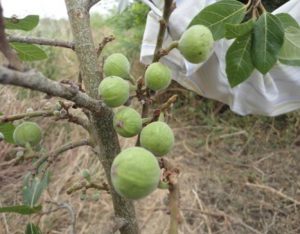– by Krishanmurti & Omkar Hande
For thousands of years, local communities and traditional medicinal systems around the world have utilized plants as a form of treatment for various ailments. This practice has highlighted the importance of medicinal plants in conventional medical procedures, which in turn has established a foundation for biodiversity study and conservation. In developing countries, medicinal plants play a crucial role in healthcare due to economic and psychological factors, as many individuals rely on these natural remedies for treatment. In fact, it is noteworthy that over 80% of synthetic drugs are derived from medicinal plants (Kumari et al., 2022).
In this post, we will discuss the important medicinal trees used by the Mahadev Koli tribe for the treatment of different ailments. The Mahadev Koli tribe, named after their god Mahadev, are primarily concentrated in the Bhimashankar, Kalsubai, and Trimbak peaks of the Sahyadris in Pune, Ahmednagar, and Nashik districts. They speak Marathi and use the Devanagari script, and their primary occupation is agriculture. Rice, black sesame, and finger millet are some of the crops they cultivate.
Like many other tribal communities, the Mahadev Koli have a deep belief in their native folklore medicine and have developed a great knowledge of the use of plants and their products in curing various ailments (Kareti et al., 2023). By understanding their traditional knowledge, we can appreciate the significant role that these plants play in the local community’s healthcare system. This knowledge can also contribute to the growing interest in traditional medicine and the importance of preserving traditional knowledge for future generations.

Photo Credit: Dr. Saurabh Purohit
List of Medicinal Trees with their Common Names, Family, Habitat, and Medicinal Use
1. Mangifera indica
Common Name: Mango
Family: Anacardiaceae
Habitat: Lowland tropical forests
Medicinal Use: Bark powder mixed with coconut oil is used for healing the wound

2. Bombax ceiba
Common Name: Red Silk Cotton Tree
Family: Bombacaceae
Habitat: Both wet evergreen and dry semi-deciduous tropical forests
Medicinal Use: Seeds and roots to cure Leprosy

3. Carica papaya
Common Name: Papaya
Family: Caricaceae
Medicinal Use: Leaves and fruits are used to cure toothache and also to increase immunity

Photo Credit: S. Raviraja
4. Terminalia arjuna
Common Name: Arjun tree
Family: Combretaceae
Habitat: Sub-tropical and tropical moist regions
Medicinal Use: Its bark is used to heal wounds, stop bleeding, anginal pain, hypertension, congestive heart failure, and dyslipidemia

Source: Indian biodiversity portal
5. Cassia fistula
Common Name: Golden Shower Tree
Family: Fabaceae
Habitat: Deciduous forests ranging from tropical to moist through subtropical forest zones
Medicinal Use: Fruits are used for throat infections in cattle

Photo Credit: Dr. Imran Khan YD
6. Acacia nilotica
Common Name: Gum Arabic Tree
Family: Fabaceae
Habitat: Found in arable lands and scrub jungles from plains to 300m
Medicinal Use: The fresh pods are used as medicine for Toothache and sexual diseases like Spermatorrhoea

Photo Credit: Kiran Bargali
7. Dalbergia sissoo
Common Name: Indian rosewood
Family: Fabaceae
Habitat: Native to the foothills of the Himalayas
Medicinal Use: Leaf and bark are used to treat itching, pimples, leprosy, and nausea

Source: Indian Biodiversity Portal
8. Vitex negundo
Common Name: Common Chaste tree
Family: Lamiaceae
Habitat: Near bodies of water, recently disturbed land, grasslands, and mixed open forests
Medicinal Use: Leaves are used to treat internal ulcers and external swellings

Photo Credit: Ramesh Veluchamy
9. Azadirachta indica
Common Name: Neem tree
Family: Meliaceae
Habitat: Shrublands, open woodlands, grasslands, floodplains, riparian zones (banks of watercourses), coastal sites and other disturbed natural vegetation
Medicinal Use: The juice prepared from the leaves is helpful during the acidity

Photo Credit: Dr. Imran Khan YD
10. Ficus racemosa
Common Name: Cluster Fig
Family: Moraceae
Habitat: A large deciduous forest tree
Medicinal Use: Leaves and gum from this tree are used to treat skin diseases and acidity

Photo Credit: Dr. Imran Khan YD
11. Ficus religiosa
Common Name: Sacred fig (Peepal)
Family: Moraceae
Habitat: Tropical and subtropical climates
Medicinal Use: Stem bark extract with jaggary is given to cattle to remove the placenta after delivery

Photo Credit: Atul Kumar Goyal
12. Ficus benghalensis
Common Name: Banyan tree
Family: Moraceae
Habitat: Tropical Asia
Medicinal Use: Stem, bark, aerial roots, underground roots, vegetative buds, leaves, fruit and latex are used to cure several diseases like Dysentry, Insomnia and anxiety attacks

Photo Credit: Dr. Imran Khan YD
13. Syzygium cumini
Common Name: Java plum/Jamun
Family: Myrtaceae
Habitat: Moist, riverine habitats
Medicinal use: The powder of seed of the Jamun is used to promote digestion and a healthy heart and liver

14. Psidium guajava
Common Name: Guava
Family: Myrtaceae
Habitat: Tropical and subtropical areas worldwide
Medicinal use: Leaves are used for blood purification, diarrhea, and vomiting

Source: Indian Biodiversity Portal
15. Bridelia retusa
Common Name: Spinous Kino Tree
Family: Phyllanthaceae
Habitat: Deciduous forests
Medicinal use: Leaf, stem, bark, and roots are used to cure cough

Photo Credit: Ankur Patwardhan
16. Ziziphus mauritiana
Common Name: Indian jujube/Ber
Family: Rhamnaceae
Habitat: Mostly in tropical forests but has also been found in stubbles, pastures, coastal ranges, tropical mountain areas, and wet to dry interior regions
Medicinal use: The leaves are used to treat scorpion bite, asthma, diabetes, inflammation, and hepatic diseases

Photo Credit: Dr. Imran Khan YD
17. Aegle marmelos
Common Name: Stone apple/Bael
Family: Rutaceae
Habitat: Dry forests on hills and plains, also in mixed deciduous and dry dipterocarp forests
Medicinal use: The fine paste from a handful of fresh leaves in sheep’s milk is massaged topically on the forehead to relieve the headache

Photo Credit: Neeti Sharma
18. Emblica officinalis
Common Name: Indian gooseberry/Amla
Family: Phyllanthaceae
Habitat: Semi-arid regions and plains of northern India
Medicinal use: The fruit is one of the major components of Triphala Churna

19. Terminalia chebula
Common Name: Myrobylan/Hirda
Family: Combretaceae
Habitat: Mixed dry deciduous forests
Medicinal use: The fruit is used to make Triphala Churna

Photo Credit: Shaimaa Negm
20. Terminalia bellirica
Common Name: Baheda
Family: Combretaceae
Habitat: Scattered in deciduous forest and evergreen forest, in dry regions associated with teak, sometimes in considerable numbers
Medicinal use: The fruit is used to make Triphala Churna, and it is also used as medicine for swine flu

Triphala churna is a composition made from Beheda (Terminalia bellirica), Hirda (Terminalia chebula), and Amla (Phyllanthus emblica) tree species. It is known for its use in improving overall gastrointestinal health and lowering blood sugar and cholesterol.
The Importance of People’s Biodiversity Register and Traditional Knowledge in Biodiversity Conservation
Overall, the Mahadev Koli tribe’s use of medicinal trees is a reflection of the rich biodiversity and cultural diversity that exists in India. By exploring and learning from the practices of indigenous communities like Mahadev Koli, we can develop a better understanding of the intricate relationship between nature and human well-being.
The importance of traditional knowledge in biodiversity conservation has been recognised by the Convention on Biological Diversity (CBD) as a valuable resource for maintaining the world’s ecosystems. One important tool to officially register traditional/indigenous knowledge is the People’s Biodiversity Register (PBR). PBR is a comprehensive database that records the traditional knowledge, current status, and utilization pattern of biodiversity in a decentralized manner.
Having a PBR is important as it provides a platform for documenting traditional knowledge and biodiversity in a systematic and scientific manner. The data collected in PBR can be used for making informed decisions about biodiversity conservation, utilization, and sustainable development. Furthermore, it helps in identifying the gaps in the understanding of traditional knowledge and areas that require further research.
There are various formats for PBR, but it requires a certain level of expertise to use. To address this issue, WOTR has simplified the PBR methodology and modified the formats to make it easy for the local community to collect practical and precise data on biodiversity. This approach is useful to develop PBR at the village level, which is an important step towards recognizing and preserving traditional knowledge.
Conserving Biodiversity for Effective Ecosystems-Based Adaptation
Conserving biodiversity is essential for effective ecosystems-based adaptation. Biodiversity ensures that ecosystems have the resilience and flexibility needed to adapt to changing conditions, including climate change. By conserving biodiversity, we can help ensure that ecosystems continue to provide essential services such as water purification, carbon sequestration, and nutrient cycling, which are critical for supporting human well-being and livelihoods.
References:
- Convention on Biological Diversity. (n.d.). Traditional knowledge.
- People’s Biodiversity Register. (2017).
- Kareti, S.R., Haran, R.H., Rajpoot, V.S., 2023. Diversity of Ethnomedicinal Plants among Tribal Communities in Anuppur District, Madhya Pradesh, Central India. J. Herbs Spices Med. Plants 29, 1–23.
- Kumari, N., Radha, Kumar, M., Mekhemar, M., Lorenzo, J.M., Pundir, A., Devi, K.B., Prakash, S., Puri, S., Thakur, M., Rathour, S., Rais, N., Jamwal, R., Kumar, A., Dhumal, S., Singh, S., Senapathy, M., Dey, A., Chandran, D., Amarowicz, R., Andrade-Cetto, A., 2022. Therapeutic uses of wild plant species used by rural inhabitants of Kangra in the western Himalayan region. South Afr. J. Bot. 148, 415–436.






